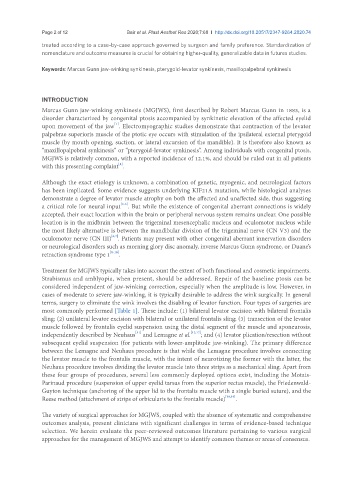Page 798 - Read Online
P. 798
Page 2 of 12 Bair et al. Plast Aesthet Res 2020;7:68 I http://dx.doi.org/10.20517/2347-9264.2020.74
treated according to a case-by-case approach governed by surgeon and family preference. Standardization of
nomenclature and outcome measures is crucial for obtaining higher-quality, generalizable data in futures studies.
Keywords: Marcus Gunn jaw-winking synkinesis, pterygoid-levator synkinesis, maxillopalpebral synkinesis
INTRODUCTION
Marcus Gunn jaw-winking synkinesis (MGJWS), first described by Robert Marcus Gunn in 1883, is a
disorder characterized by congenital ptosis accompanied by synkinetic elevation of the affected eyelid
[1]
upon movement of the jaw . Electromyographic studies demonstrate that contraction of the levator
palpebrae superioris muscle of the ptotic eye occurs with stimulation of the ipsilateral external pterygoid
muscle (by mouth opening, suction, or lateral excursion of the mandible). It is therefore also known as
“maxillopalpebral synkinesis” or “pterygoid-levator synkinesis”. Among individuals with congenital ptosis,
MGJWS is relatively common, with a reported incidence of 12.1%, and should be ruled out in all patients
[2]
with this presenting complaint .
Although the exact etiology is unknown, a combination of genetic, myogenic, and neurological factors
has been implicated. Some evidence suggests underlying KIF21A mutation, while histological analyses
demonstrate a degree of levator muscle atrophy on both the affected and unaffected side, thus suggesting
[3-5]
a critical role for neural input . But while the existence of congenital aberrant connections is widely
accepted, their exact location within the brain or peripheral nervous system remains unclear. One possible
location is in the midbrain between the trigeminal mesencephalic nucleus and oculomotor nucleus while
the most likely alternative is between the mandibular division of the trigeminal nerve (CN V3) and the
[6,7]
oculomotor nerve (CN III) . Patients may present with other congenital aberrant innervation disorders
or neurological disorders such as morning glory disc anomaly, inverse Marcus Gunn syndrome, or Duane’s
retraction syndrome type 1 [8-10] .
Treatment for MGJWS typically takes into account the extent of both functional and cosmetic impairments.
Strabismus and amblyopia, when present, should be addressed. Repair of the baseline ptosis can be
considered independent of jaw-winking correction, especially when the amplitude is low. However, in
cases of moderate to severe jaw-winking, it is typically desirable to address the wink surgically. In general
terms, surgery to eliminate the wink involves the disabling of levator function. Four types of surgeries are
most commonly performed [Table 1]. These include: (1) bilateral levator excision with bilateral frontalis
sling; (2) unilateral levator excision with bilateral or unilateral frontalis sling; (3) transection of the levator
muscle followed by frontalis eyelid suspension using the distal segment of the muscle and aponeurosis,
[11]
independently described by Neuhaus and Lemagne et al. [12,17] ; and (4) levator plication/resection without
subsequent eyelid suspension (for patients with lower-amplitude jaw-winking). The primary difference
between the Lemagne and Neuhaus procedure is that while the Lemagne procedure involves connecting
the levator muscle to the frontalis muscle, with the intent of neurotizing the former with the latter, the
Neuhaus procedure involves dividing the levator muscle into three strips as a mechanical sling. Apart from
these four groups of procedures, several less commonly deployed options exist, including the Motais-
Parinaud procedure (suspension of upper eyelid tarsus from the superior rectus muscle), the Friedenwald-
Guyton technique (anchoring of the upper lid to the frontalis muscle with a single buried suture), and the
Reese method (attachment of strips of orbicularis to the frontalis muscle) [18,19] .
The variety of surgical approaches for MGJWS, coupled with the absence of systematic and comprehensive
outcomes analysis, present clinicians with significant challenges in terms of evidence-based technique
selection. We herein evaluate the peer-reviewed outcomes literature pertaining to various surgical
approaches for the management of MGJWS and attempt to identify common themes or areas of consensus.

